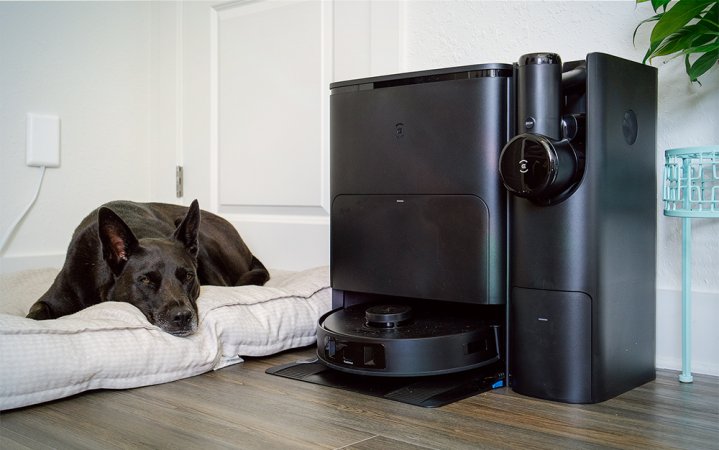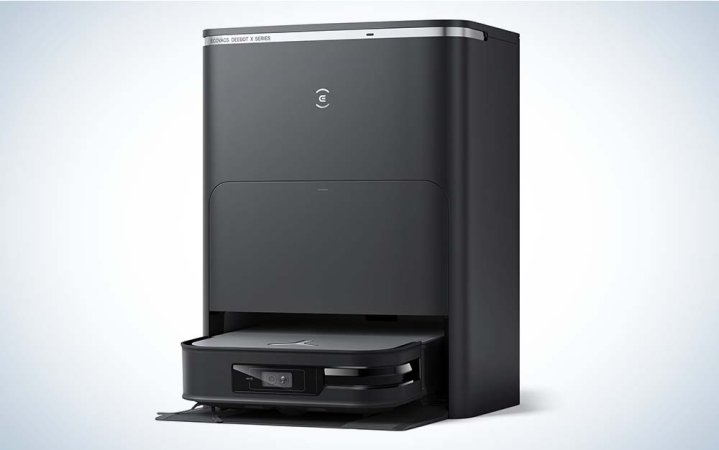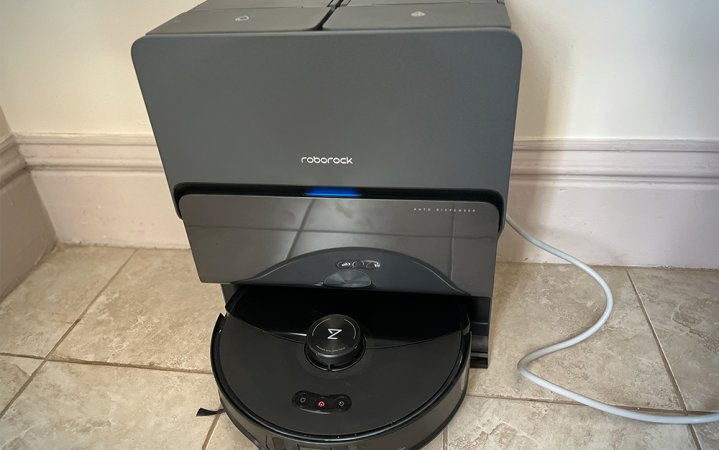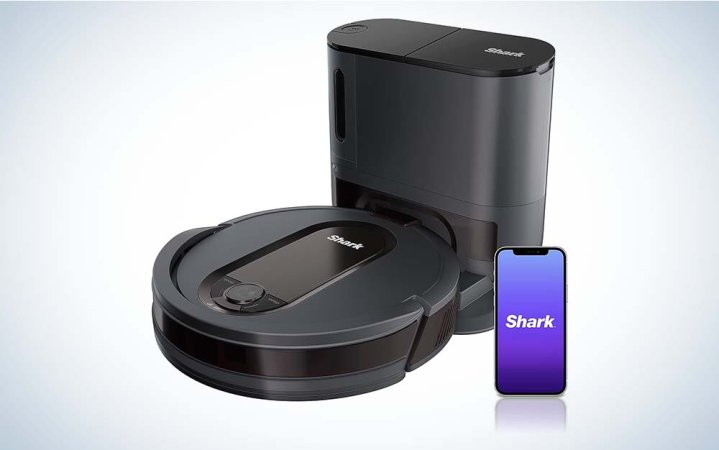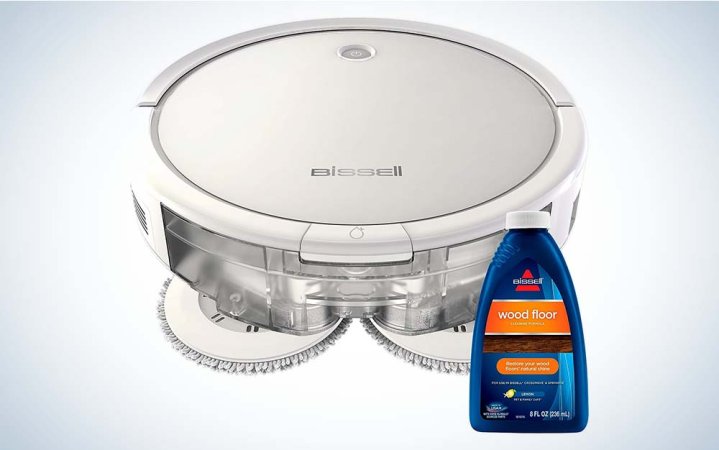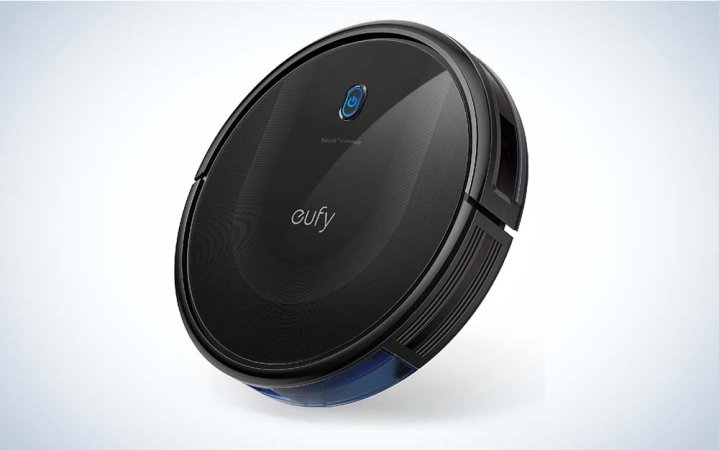We may earn revenue from the products available on this page and participate in affiliate programs. Learn more ›

Pet owners know keeping fur from collecting in corners, couch crevices, and our clothes is a Sisyphean task, but a robot vacuum for pet hair can help. It doesn’t matter if scritch sessions end in a handful of Himalayan or husky; our fate is to vacuum again and again, forever. But that kind of menial, repetitive task can easily be outsourced to a robot vacuum that will never tire—even during seasonal shedding. Since their debut, robot vacuums have gotten smarter, stronger, and added a bunch of bells and whistles like scheduling, hands-free emptying, and mops so you can delegate more cleaning tasks (all featured in our best overall pick, the ECOVACS Deebot T30S Combo). Here’s our guide to finding the best robot vacuums for pet hair so that you can spend more time with your furry friend(s) and less worrying about the floors.
- Best overall: ECOVACS Deebot T30S Combo
- Best splurge: roborock S8 MaxV Ultra Robot Vacuum & Sonic Mop
- Best value: iRobot Roomba s9+ Self-Emptying Robot Vacuum
- Best self-emptying: Shark RV912S EZ Robot Vacuum with Self-Empty Base
- Best for hardwood floors: Bissell SpinWave Hard Floor Expert Pet Robot, 2-in-1 Wet Mop and Dry Robot Vacuum
- Best budget: eufy BoostIQ RoboVac 11S MAX
How we chose the best robot vacuums for pet hair
As long-time pawrents, we understand fur is nature’s glitter; it’s magically everywhere, hard to remove, and turns up where you least expect it. It takes a combination of frequent maintenance and deep cleaning to keep a house clear of tumbleweeds of fluff and allergens. As much as robot vacuums have stronger suction than they used to (we recommend paying, at a minimum, for models with at least 2500Pa—aka Pascals, the vacuum force for listing debris), they are best at tackling the frequency part of the equation. Have them do a lap around the house a few times a week (or daily!) to delay how often you need to drag out a traditional vacuum and its arsenal of brushes and tools for furniture. (And here are our suggestions for regular vacuums for pet hair.) With that in mind, we made recommendations based on hands-on experience, research, and reviews to find a reliable robot helper.
The best robot vacuums for pet hair: Reviews & Recommendations
The right robot vacuum depends on how many furry friends you have, their coats, how much they shed, and what floor types need to be cleaned. A house with an American domestic short-hair cat and hard floors may want a machine that can pick up litter and do some mopping. Anyone with a herd of shepherds may want a self-emptying base to minimize how often they dump all that hair. Or maybe you want an affordable machine to supplement your other vacuum. Either way, we’ve got you covered.
Best overall: ECOVACS Deebot T30S Combo
Pros
- Self-empties and self-cleans mop pads
- Relatively quiet
- Lots of cleaning modes
- App is easy to navigate
- Dries mops pads once complete
- TrueDetect 3d is very gentle with obstacles
- Includes a handheld vacuum with attachments
Cons
- Expensive
- Docking station takes up a lot of room
- Handheld vacuum doesn’t last very long
Specs
- Robot dimensions: 4.1 inches tall by 13.9 inches wide
- Robot weight: Not provided
- Base dimensions: 20.8 inches tall by 21.8 inches wide by 17.4 inches deep
- Surfaces: Carpets and hard floors
- Bin size: 3 liters
- Run time: Maximum 290 minutes (silent mode, sweep only)
The ECOVACS Deebot T30S Combo is a feature-packed, multi-purpose machine capable of keeping most areas of your home clean. The star of the show is the robot that doubles as a vacuum and mop. You can use it to only vacuum, vacuum and mop, or vacuum and then mop. There are options for three different water flow rates, four suction power modes, three cleaning speeds, and one or two passes, so you can truly customize your cleaning. It even has an AI feature called Intelligent Hosting, which will generate settings based on your cleaning habits, cleaning history, floor materials, room types, and how dirty the floors are.
The robot portion is connected to Wi-Fi, and it uses a top-mounted LiDAR system to deliver a map of your home to the app. Once the initial TrueMapping is completed, you can adjust it to add or combine rooms, name rooms, or create virtual boundaries. The initial map of our apartment was a bit wonky and required some adjustments to get an accurate layout, and adjusting the map was a tad annoying. But, once it’s set up, it allows you to clean only certain rooms or create custom scenarios. For example, when I’m working from home, I don’t want the robot cleaning my office, but I can set it to clean the rest of the house without manually selecting each room.
When it comes to vacuuming, the robot’s 11,000Pa suction is plenty powerful, even in the standard suction mode. It easily gathers all the loose dog and cat hair, even on our plush rug. Then, it self-empties when done, so I don’t have to remember to do it before I need to run it the next time. As an added benefit, the standard suction mode is much quieter than my previous iRobot vacuum, so it’s less obtrusive to run when I’m home. And, thanks to a 3D structured light-plus-lasers system, there were no issues with obstacles.

For mopping, it self-fills with clean water, returning to the base during a job to empty the dirty water, detect how dirty the water is and if the job needs to keep running, hot wash the mop pads, and refill clean water. When it’s all done, it again self-cleans the mop pads and dries them, so they aren’t sitting there damp, liable to form mold. The dual mopping pads lift automatically when the robot finds a rug or carpet, and I haven’t found a wet mess on my rugs yet. The mop pads turn quickly to produce an actual scrubbing motion and do a fantastic job of cleaning our laminate floors. I set up the machine while my husband was on vacation, and he commented how clean and shiny the floors looked when he got home, which never happens.
The Combo portion of this setup includes a handheld vacuum and three attachments. It’s lighter than cordless vacuums that double as handheld machines, making it easy to spot clean quick messes here and there. It takes a few seconds to wind up to full suction, but then it is quite powerful. Unfortunately, that power doesn’t last very long, and you’ll need to charge it up after only about 15 minutes of cleaning. The Combo version also has a very large docking station, so you’ll need plenty of room in your home for this setup.
Also worth considering: ECOVACS Deebot X2 Omni Robot Vacuum and Mop
Pros
- 3D mapping
- Four cleaning modes: vacuum only, mop only, vacuum before mop, vacuum and mop
- Mop pads lift when not in use
- OMNI station automates emptying, water refilling, and drying
- AI-controlled obstacle avoidance
- Lidar sensor
- YIKO voice assistant
- Wi-Fi connected
Cons
- Pricey
- Durability to be determined
Specs
- Robot dimensions: 3.7 inches tall by 13.9 inches wide by 12.6 inches deep
- Base dimensions: 20.8 inches tall by 15.5 inches wide by 17.4 inches deep
- Surfaces: Carpets and hard floors
- Bin size: Reported 90 days of dirt
- Water tank size: 4 liters
- Run time: Maximum 210 minutes
While the Ecovacs Deebot X2 Omni Robot Vacuum and Mop isn’t The Jetsons’s Rosey, it’s getting close. This flagship model comes stacked with high-tech features like artificial intelligence to suggest how to clean up a mess, as well as a LiDAR sensor—a type of laser detection and ranging technology used on self-driving cars and other autonomous vehicles. It maps in 3D and can be sent to spot clean by pointing it out on the app. Also, its internal sensor array (rather than the top-mounted version of the T30 above) allows it to slip underneath couches and tables more easily.
It also comes with a voice assistant and can make two-way video calls if you want to see what your pet is up to. We haven’t done an in-home test yet, but we saw a demonstration where the squared-off robot successfully dodged toys, power cords, and expensive short-throw projectors on hardwood, holding a tight line with a wall while also sensing the need to lift its mop pads as it went over a carpet (15mm of lift helps clearance).
In addition to the kind of tech that can keep a vacuum from knocking over a pet’s water bowl, and 8000Pa suction to get all the stray kibble and undercoat, the X2 Omni has a mode where vacuuming and mopping happen simultaneously. It’s a time saver and a big plus if vacuums stress out your pet (after all, we want to clean up any puppy puddles, not inspire new ones). The dock, dubbed the Omni station, automates a lot of the floor care that most people don’t want to deal with, like emptying the dust bin, refilling the robot’s water tank, and cleaning and drying the dual mop pads after use. The convenience comes at a recommended price of $1,499, but we’ve seen deals that knock that down to a grand.
Best splurge: roborock S8 MaxV Ultra Robot Vacuum & Sonic Mop
Pros
- Robust app and features
- Easy set-up
- Great object detection
Cons
- Smart doesn’t mean error-free
- Expensive
- Doesn’t fully replace a human
Specs
- Robot dimensions: 13.8 x 13.9 x 4.06 inches
- Robot weight: 32.19 lbs.
- Base dimensions: 16.1 x 16.5 x 18.5 inches
- Surfaces: Carpet and hard floors
- Bin size: Up to 7 weeks’ worth of debris
- Run time: 180 minutes
I haven’t had the best luck with robovacs. The last one I tested—a Neato D10, which I feel comfortable naming since the company ceased sales operations—was absolutely awful, constantly getting stuck because my apartment is not an empty square box, but rather a place with furniture, shoes strewn around, and charging cords acting as tripwires. I gave the robot a name—Donny Neato—and called him my dumb robot son, as anthropomorphizing him stopped me from throwing him in the dumpster. After donating Donny Neato, I determined that a person controlling the vacuum cleaner was the best option for getting the cleanest clean. I still stand by that, but my roborock S8 MaxV Ultra Robot Vacuum & Sonic Mop, christened Rocky, has done a great job of getting close to what a human can accomplish.
The roborock S8 MaxV Ultra Robot Vacuum & Sonic Mop has 10,000Pa of suction power, so no crumbs are left behind (until they are automatically emptied in the substantial bin/dock), and its FlexiArm side brush gets the nooks and crannies your stick vacuum can’t. The sonic mopping system can scrub a spot 4,000 times per minute, has auto detergent dispensing, and pads lift 20 millimeters above the ground so your carpets remain dry. Speaking of dry, it has hot air self-drying.
The robovac’s obstacle recognition and LiDAR navigation are where it shines. I haven’t had to rescue my vacuum from carpets and corners, and it’s only sucked up a rogue umbrella or wayward cable a handful of times. And it maps out my house and remembers previously detected objects to prevent a fiasco, while getting as close to the edges as robotically possible.
The roborock S8 MaxV Ultra Robot Vacuum & Sonic Mop has pet-friendly features that I did not utilize since my cat, JunkJunk, is terrified of all vacuums. Video Call lets you check on pets by scheduling automated cruises to track down Fido and/or Fluffy and enjoy two-way video calls. Pet Snaps lets the S8 MaxV Ultra capture snapshots of furry companions during cleanups. The app also has a button that makes the S8 MaxV Ultra track down your pet like it’s Kyle Reese (or the T-800), your furry friend is Sarah Connor, and you just want to say, “Don’t knock that over if you want to live.” You can actually say, “Hello Rocky,” to start and adjust cleaning once everything is set up properly.
Although it’s a smart robovac, it’s still a little dumb sometimes. Even at $1,799, these things aren’t perfect. Rocky has had a hard time getting back onto her base more than once. She’s eaten the computer charger to my boyfriend’s work computer (OK, anti-capitalist queen!). She hasn’t mastered utilizing her mop. But, as someone who loves saving time and trouble by having an assistant do a scheduled daily sweep that gets the litter and dust bunnies, she’s perfect.
Best value: iRobot Roomba s9+ Self-Emptying Robot Vacuum
Pros
- Self-emptying design
- Three levels of cleaning
- Smart mapping
- D-shaped robot
- Dual rubber brushes
- Customizable no-go zones
- Alexa, Siri, and Google voice assistant compatible
- WiFi connected
Cons
- Pricey
- Noisy
- Some app complaints
Specs
- Robot dimensions: 3.5 inches tall by 12.3 inches wide
- Robot weight: 8.2 pounds
- Base dimensions: 19 inches tall by 11.5 inches wide by 15 inches deep
- Surfaces: Carpets and hard floors
- Bin size: 60 days of dirt
- Run time: Maximum 120 minutes
So many intelligent features are packed in the iRobot Roomba s9+ Self-Emptying Robot Vacuum that they’re hard to list. The WiFi-connected robot features smart mapping, programmable no-go zones, and the ability to send it out for spot cleaning. It is also compatible with many voice assistants, including the big three: Alexa, Siri, and Google.
The black-and-bronze robot effortlessly weaves through furniture. Its D-shape allows it to maneuver into corners better than some round machines we’ve tested. Its various sensors help it dodge socks and toys we fail to pick up. The powerful suction and dual rubber brushes easily pick up large debris and ably pull up dog hair ground into the carpet. Occasionally, it leaves a wad of fur in its wake when it goes to empty the bin, but it often picks it up as it shimmies through a second sweep (though not always). Not all robot vacuums have self-emptying bases, but pet owners will find it well worth it to avoid handling a mix of fur and floor grunge. The Roomba s9+ empties itself into a bag, which may need frequent replacing in a high-fluff house.
When the Roomba s9+ debuted, it was the top-of-the-line vacuum with a matching price of $1,000. However, Roomba has released new models and dropped the cost of the s9+ considerably, making it a better value. It can also be linked to iRobot’s Braava Robot Mop (included in our best Roombas guide). Users report two main complaints: the app has occasional weirdness, like losing maps, and both the 2500Pa robot and its dock are loud.
Best self-emptying: Shark RV912S EZ Robot Vacuum with Self-Empty Base
Pros
- Self-emptying base
- Bagless
- Room mapping
- Google and Alexa compatible
- WiFi connected
- Can schedule cleaning
Cons
- Noisy
- Not great at edges and corners
- Some users have difficulty with the app
Specs
- Robot weight: 12.2 pounds
- Base dimensions: 11.4 inches tall by 18.5 inches wide by 13.4 inches deep
- Surfaces: Carpets and hard floors
- Bin size: 30 days of dirt
- Run time: Maximum 60 minutes
You don’t have to drop a fortune to get a self-emptying base for a robot vacuum. The Shark RV912S EZ Robot Vacuum with Self-Empty Base is an older but reliable model that empties itself into a bin with no bag. Just dump the container after about a month of cleanings. The EZ Robot goes row by row to clean a room and can resume a cleaning where it left off should it recharge before the room is done. Google Assistant, Alexa, or the app can be used to control and schedule cleanings, though some users report issues with the app connecting. The round bot is a little clunky. It has a built-in bumper, which is good because it sometimes bumps into furniture.
Best for hardwood floors: Bissell SpinWave Hard Floor Expert Pet Robot, 2-in-1 Wet Mop and Dry Robot Vacuum
Pros
- Vacuums and mops
- Two-tank system
- Uses cleaning solution specially designed for wood floors
- Donates money to support homeless pets with every purchase
- Cleans with reusable pads
- Can schedule cleaning
- WiFi connected
- Quiet
Cons
- No mapping
- Sometimes bumps into furniture
- Must use Bissell cleaners or warranty is voided
Specs
- Robot dimensions: 4 inches tall by 13 inches wide by 14 inches deep
- Robot weight: 7.5 pounds
- Surfaces: Hard floors, low- to medium-pile carpets
- Run time: 130 minutes
Bissell has long made wet/dry vacuums, but the Bissell SpinWave Hard Floor Expert Pet Robot, 2-in-1 Wet Mop and Dry Robot Vacuum is its first robot that does both. Swap in the dry tank to have it vacuum, or put in the water tank to mop with two spinning, washable pads. This versatility helps out pet parents with a lot of hard floors to keep clean. At this mid-range price, the SpinWave delivers more than expected, like an app that offers customized cleaning priorities, the option to build a cleaning schedule, and quiet operation.
Even though it doesn’t have advanced mapping features, the SpinWave cleans in tidy rows instead of bumping around randomly. The mopping mode avoids carpets with a soft surface sensor and is safe for hardwood floors, vinyl, and tile. The SpinWave also uses Bissell’s range of proprietary cleaners instead of the plain water most robot mops suggest. However, the solution evaporates rather than being suctioned up, so furry friends should be kept out until dry.
Best budget: eufy BoostIQ RoboVac 11S MAX
Pros
- Inexpensive
- Quiet
- Remote control
- Amazon Echo compatible
Cons
- Not “smart”
Specs
- Robot dimensions: 2.9 inches tall by 12.8 inches wide by 12.8 inches deep
- Robot weight: 5.7 pounds
- Surfaces: Carpets and hard floors
- Run time: Maximum 100 minutes
Look no further than the eufy BoostIQ RoboVac 11S MAX for an affordable robot vacuum. It’s a bit old-school because it doesn’t map or go row by row. Instead, it cuts a random path through a room but features anti-collision technology and drop-sensors so it doesn’t fall down stairs. It has about 100 minutes of cleaning time, 2000Pa of suction, and is relatively quiet. It’s also under three inches tall, easily fitting under couches where fluff transforms into dust bunnies. At around $250 (and often on sale), it’s a highly rated model for people looking for simple operation without apps or cameras.
What to consider when buying the best robot vacuums for pet hair
Budget
As robot vacuums have become more common, their prices have dropped while the features you can get for your money have increased. Entry-level robot vacuums can start around $100, but they’re often made by obscure or unknown brands and have that erratic, bump-and-go style. Determine your budget and think about how smart—or not—you want the robot to be. Remember that more expensive connected smart-home models often have advanced features, like sophisticated sensors, voice control, and mapping technology.
Robot height and shape
In the robot vacuum world, short kings reign supreme. It’s worth measuring low furniture to see how much clearance is available. Can a robot move freely under a platform bed, or will it get trapped? A robot’s shape can impact cleaning, too. D-shaped or squared-off bots can get closer to corners and edges than round ones.
Room for a dock
A regular vacuum can live in a closet or a spare corner, but a robot vacuum needs space around its dock. Manufacturers’ guidance varies, but they often recommend a foot and a half to three feet of space on either side of the dock and four feet of empty space in front of it. And you’ll need a power plug.
Privacy
All smart tech comes with privacy concerns; robot vacuums are no different. Robots that map our homes are inherently collecting private data. Devices that connect to WiFi open the possibility of that data being accessed by someone else by accident or design. The advanced cameras some models use to map and identify objects also capture images of our home’s interior and potentially our family members. If this freaks you out, opt for a bot that doesn’t connect to the internet or has cameras, but it won’t be able to avoid pet waste.
FAQs
Your pet’s reaction will be highly individual. The internet is full of videos of cats triumphantly riding robot vacuums and dogs barking aggressively at them. My doggo gives robot vacuums plenty of space, preferring to monitor them from the top of a couch and occasionally giving them a suspicious sniff when they’re docked. She doesn’t care for traditional vacuums, either.
After stories of a Roomba smearing dog poo went viral back in 2016, iRobot unveiled a P.O.O.P. (Pet Owner Official Promise) for select models to replace a vacuum if it runs over solid waste. Since then, many manufacturers released models with avoidance technology, like advanced cameras and artificial intelligence, but those aren’t standard features.
Pet hair and human hair can both get stuck in a robot vacuum, though rubber rollers seem to avoid this better than bristle brushes. Like all vacuums, regular maintenance will be required to keep brushes, rollers, filters, and bins from getting clogged.
Final thoughts on the best robot vacuums for pet hair
- Best overall: ECOVACS Deebot T30S Combo
- Best splurge: roborock S8 MaxV Ultra Robot Vacuum & Sonic Mop
- Best value: iRobot Roomba s9+ Self-Emptying Robot Vacuum
- Best self-emptying: Shark RV912S EZ Robot Vacuum with Self-Empty Base
- Best for hardwood floors: Bissell SpinWave Hard Floor Expert Pet Robot, 2-in-1 Wet Mop and Dry Robot Vacuum
- Best budget: eufy BoostIQ RoboVac 11S MAX
Robot vacuums were practically made for pet owners, saving time and effort. While we think the self-emptying base, advanced mapping features, and ability to block out no-go zones make iRobot Roomba s9+ Self-Emptying Robot Vacuum the best overall pick for a robot vacuum, all of the options on this list can ably cut down fur and dander without a ton of human effort.



